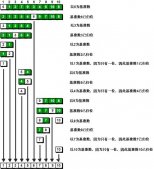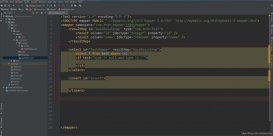本文實例分析了基于java解析JSON的三種方式。分享給大家供大家參考,具體如下:
一、什么是JSON?
JSON是一種取代XML的數據結構,和xml相比,它更小巧但描述能力卻不差,由于它的小巧所以網絡傳輸數據將減少更多流量從而加快速度。
JSON就是一串字符串 只不過元素會使用特定的符號標注。
{} 雙括號表示對象
[] 中括號表示數組
"" 雙引號內是屬性或值
: 冒號表示后者是前者的值(這個值可以是字符串、數字、也可以是另一個數組或對象)
所以 {"name": "Michael"} 可以理解為是一個包含name為Michael的對象
而[{"name": "Michael"},{"name": "Jerry"}]就表示包含兩個對象的數組
當然了,你也可以使用{"name":["Michael","Jerry"]}來簡化上面一部,這是一個擁有一個name數組的對象
二、JSON解析之傳統的JSON解析
1、生成json字符串
|
1
2
3
4
5
|
public static String createJsonString(String key, Object value) { JSONObject jsonObject = new JSONObject(); jsonObject.put(key, value); return jsonObject.toString();} |
2、解析JSON字符串
分為以下三種情況,一個JavaBean,一個List數組,一個嵌套Map的List數組:
|
1
2
3
4
5
6
7
8
9
10
11
12
13
14
15
16
17
18
19
20
21
22
23
24
25
26
27
28
29
30
31
32
33
34
35
36
37
38
39
40
41
42
43
44
45
46
47
48
49
50
51
52
53
54
55
56
57
58
59
60
61
62
63
64
65
66
67
68
69
70
71
72
73
74
75
76
77
78
79
80
81
82
83
84
85
|
import java.util.ArrayList;import java.util.HashMap;import java.util.Iterator;import java.util.List;import java.util.Map;import org.json.JSONArray;import org.json.JSONObject;import com.android.myjson.domain.Person;/** * 完成對json數據的解析 * */public class JsonTools { public static Person getPerson(String key, String jsonString) { Person person = new Person(); try { JSONObject jsonObject = new JSONObject(jsonString); JSONObject personObject = jsonObject.getJSONObject("person"); person.setId(personObject.getInt("id")); person.setName(personObject.getString("name")); person.setAddress(personObject.getString("address")); } catch (Exception e) { // TODO: handle exception } return person; } public static List getPersons(String key, String jsonString) { List list = new ArrayList(); try { JSONObject jsonObject = new JSONObject(jsonString); // 返回json的數組 JSONArray jsonArray = jsonObject.getJSONArray(key); for (int i = 0; i < jsonArray.length(); i++) { JSONObject jsonObject2 = jsonArray.getJSONObject(i); Person person = new Person(); person.setId(jsonObject2.getInt("id")); person.setName(jsonObject2.getString("name")); person.setAddress(jsonObject2.getString("address")); list.add(person); } } catch (Exception e) { // TODO: handle exception } return list; } public static List getList(String key, String jsonString) { List list = new ArrayList(); try { JSONObject jsonObject = new JSONObject(jsonString); JSONArray jsonArray = jsonObject.getJSONArray(key); for (int i = 0; i < jsonArray.length(); i++) { String msg = jsonArray.getString(i); list.add(msg); } } catch (Exception e) { // TODO: handle exception } return list; } public static List> listKeyMaps(String key, String jsonString) { List> list = new ArrayList>(); try { JSONObject jsonObject = new JSONObject(jsonString); JSONArray jsonArray = jsonObject.getJSONArray(key); for (int i = 0; i < jsonArray.length(); i++) { JSONObject jsonObject2 = jsonArray.getJSONObject(i); Map map = new HashMap(); Iterator iterator = jsonObject2.keys(); while (iterator.hasNext()) { String json_key = iterator.next(); Object json_value = jsonObject2.get(json_key); if (json_value == null) { json_value = ""; } map.put(json_key, json_value); } list.add(map); } } catch (Exception e) { // TODO: handle exception } return list; }} |
三、JSON解析之GSON
1、生成JSON字符串
|
1
2
3
4
5
6
7
8
|
import com.google.gson.Gson;public class JsonUtils { public static String createJsonObject(Object obj) { Gson gson = new Gson(); String str = gson.toJson(obj); return str; }} |
2、解析JSON
|
1
2
3
4
5
6
7
8
9
10
11
12
13
14
15
16
17
18
19
20
21
22
23
24
25
26
27
28
29
30
31
32
33
34
35
36
37
38
39
40
41
42
43
44
45
46
47
48
49
50
51
52
53
54
55
56
57
58
59
60
61
62
63
64
65
66
67
68
69
70
71
72
|
import java.util.ArrayList;import java.util.List;import java.util.Map;import com.google.gson.Gson;import com.google.gson.reflect.TypeToken;;public class GsonTools { public GsonTools() { // TODO Auto-generated constructor stub } /** * @param * @param jsonString * @param cls * @return */ public static T getPerson(String jsonString, Class cls) { T t = null; try { Gson gson = new Gson(); t = gson.fromJson(jsonString, cls); } catch (Exception e) { // TODO: handle exception } return t; } /** * 使用Gson進行解析 List * * @param * @param jsonString * @param cls * @return */ public static List getPersons(String jsonString, Class cls) { List list = new ArrayList(); try { Gson gson = new Gson(); list = gson.fromJson(jsonString, new TypeToken>() { }.getType()); } catch (Exception e) { } return list; } /** * @param jsonString * @return */ public static List getList(String jsonString) { List list = new ArrayList(); try { Gson gson = new Gson(); list = gson.fromJson(jsonString, new TypeToken>() { }.getType()); } catch (Exception e) { // TODO: handle exception } return list; } public static List> listKeyMaps(String jsonString) { List> list = new ArrayList>(); try { Gson gson = new Gson(); list = gson.fromJson(jsonString, new TypeToken>>() { }.getType()); } catch (Exception e) { // TODO: handle exception } return list; }} |
四、JSON解析之FastJSON
|
1
2
3
4
5
6
7
8
9
10
11
12
13
14
15
16
17
18
19
20
21
22
23
24
25
26
27
28
29
30
31
32
33
34
35
36
37
|
import java.util.ArrayList;import java.util.List;import java.util.Map;import com.alibaba.fastjson.JSON;import com.alibaba.fastjson.TypeReference;public class JsonTool { public static T getPerson(String jsonstring, Class cls) { T t = null; try { t = JSON.parseObject(jsonstring, cls); } catch (Exception e) { // TODO: handle exception } return t; } public static List getPersonList(String jsonstring, Class cls) { List list = new ArrayList(); try { list = JSON.parseArray(jsonstring, cls); } catch (Exception e) { // TODO: handle exception } return list; } public static List> getPersonListMap1( String jsonstring) { List> list = new ArrayList>(); try { list = JSON.parseObject(jsonstring, new TypeReference>>() { }.getType()); } catch (Exception e) { // TODO: handle exception } return list; }} |
總結:
JSON對于移動設備來說,尤其對于網絡環境較差和流量限制的情況下,相對于XML格式的數據傳輸會更節省流量,傳輸效率更高。在這三種解析方式中FastJson是效率最高的,推薦使用。
希望本文所述對大家java程序設計有所幫助。














